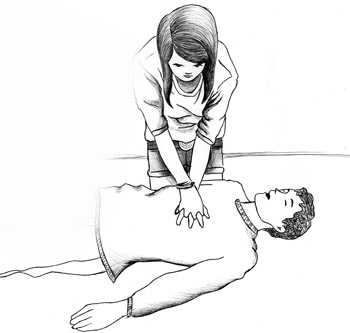How to save a life
Both of my parents have jobs in the medical field. While growing up whenever the subject of saving people came up, they would talk to me about taking a CPR course with them so that I could learn how to help someone in an emergency. My dad saved me from choking when I was in kindergarten. So I knew it was important, but I always felt too busy to take a class.
When high school started I joined the American Red Cross club at my school. My friend was the president and she said that being part of the club would look good on college applications. I became the events coordinator so I could learn some leadership skills. I found out the American Red Cross would be hosting a CPR day at Angel Stadium in Anaheim and figured it would be a great event for the club to participate in. I thought it was important for club members to learn CPR because you never know when one of us might need to save someone’s life. Unfortunately, everyone said that they couldn’t go because they were busy. I was disappointed, but it was OK because my mom came with me.
Before I took the class, I had heard of chest compressions and knew you helped the victim breathe, but I didn’t know what CPR stood for, let alone how to perform it.
I took the course in April. It was held in a large room beneath the stadium. Part of it was sectioned off for watching demonstration videos, while another section was used for practicing CPR on special mannequins used for teaching. The chests would go up and down when you pressed down during compressions. There was another big room for people to take their certification tests.
CPR is used when someone’s heart stops
To start, we watched about an hour of videos explaining how to perform the steps. I learned that CPR stands for cardiopulmonary resuscitation and it’s used when someone’s heart stops beating. You determine whether someone’s heart has stopped beating by checking if they have a pulse.
We learned that the first thing we should do is ask a victim if they want us to perform CPR. If they cannot give permission because they’re unconcsious, we should call 911 and then start performing CPR.
The instructors on the video made CPR look easy. It seemed like the lady on the screen only had to blow into the mannequin’s mouth lightly and push down on the chest gently.
We were led to an open area where mannequins were lying on mats. Each group had an instructor who described what to do.
He told us to start with checking the mannequin’s airway by tilting the head back and opening the mouth to see if there was anything in the back of the throat. If there is, we scoop it out with our index finger. Then, we blow into the mouth to give a breath. When giving breaths, you have to cover the other person’s mouth with your mouth and pinch the person’s nose from the sides and then blow two one-second breaths into the victim’s mouth. I play the oboe, an instrument that requires a lot of breath control and lung capacity, so blowing enough air to fill the mannequin’s chest wasn’t hard.
Next are the the chest compressions. We learned that the proper place to do them is two fingers below the chest, in the middle of the rib cage. We had to give two breaths before every 30 chest compressions. Chest compressions simulate heartbeats and are used to pump the oxygen from the breaths through a person’s body. The instructor kept telling me to push harder.
Chest compressions took all my strength
The compressions were the hardest for me because I am not strong. I weigh only 97 pounds, so I struggled with pushing down the mannequin’s chest hard enough. I tried my best but my hands started to hurt. I got tired after pushing down a few times. My mom and I took turns giving the chest compressions and breaths so I had a chance to rest. After 10 attempts, the mannequin’s chest started going down, meaning I was doing it correctly.
We also learned about the Heimlich maneuver, which is used to force an object out of a person’s throat when they are choking. When I was choking, my dad wrapped his arms around me and made a fist in the middle of my rib cage and pulled in, causing the food I was choking on to fly out of my mouth. Having my mom practice the Heimlich maneuver on me was difficult because I’m ticklish. But learning to do the Heimlich wasn’t hard.
After we practiced CPR, we took the certification exam. It was easy since I had paid attention while watching the video and listened to the instructors. Most of the answers were from what they had said. It was just a multiple-choice test. I missed only three questions.
The three-hour CPR certification course was definitely worth the $10. I feel that learning CPR is important and beneficial for everyone, not just paramedics and doctors. I am glad and thankful my dad knew how to perform the Heimlich maneuver or I would not be here right now. I’m proud that I learned these two life-saving techniques. It makes me feel prepared that I could help someone who was in my situation, just like my dad helped me.
To find a class near you go to redcrossla.org/classes.






